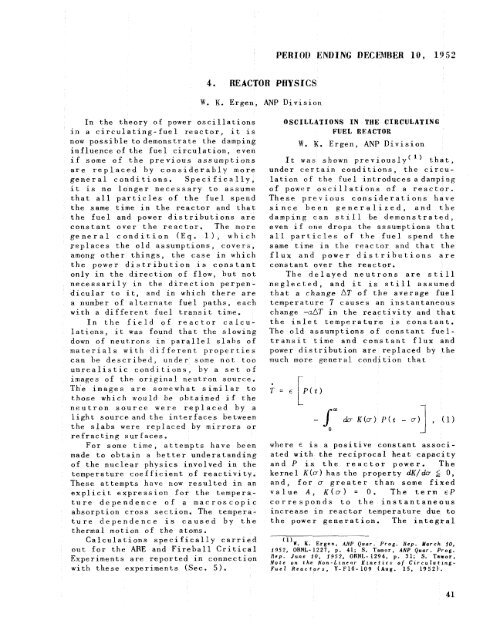the Molten Salt Energy Technologies Web Site
the Molten Salt Energy Technologies Web Site
the Molten Salt Energy Technologies Web Site
Create successful ePaper yourself
Turn your PDF publications into a flip-book with our unique Google optimized e-Paper software.
In <strong>the</strong> <strong>the</strong>ory of power oscillations<br />
in a circulating-fuel reactor, it is<br />
now possible todemonstrate <strong>the</strong> damping<br />
influence of <strong>the</strong> fuel circulation, even<br />
if some of <strong>the</strong> previous assumptions<br />
are replaced by considerably more<br />
gene r a1 c ond i ti ons Spec i f i c a 11 y ,<br />
it is no longer necessary to assume<br />
that all particles of <strong>the</strong> fuel spend<br />
<strong>the</strong> same time in <strong>the</strong> reactor and that<br />
<strong>the</strong> fuel and power distributions are<br />
constant over <strong>the</strong> reactor. The more<br />
general condition (Eq. 11, which<br />
replaces <strong>the</strong> old assumptions, covers,<br />
among o<strong>the</strong>r things, <strong>the</strong> case in which<br />
<strong>the</strong> power distribution is constant<br />
only in <strong>the</strong> direction of flow, but not<br />
necessarily in <strong>the</strong> direction perpen-<br />
dicular to it, and in which <strong>the</strong>re are<br />
a number of alternate fuel paths, each<br />
with a different fuel transit time.<br />
In <strong>the</strong> field of reactor calcu-<br />
lations, it was found that <strong>the</strong> slowing<br />
down of neutfrons in parallel slabs of<br />
ma te r i a 1 s w i t, h (1 i f f c ren t pro pe r t i e s<br />
can be described, under some not too<br />
unrealistic conditions, by a set of<br />
images of <strong>the</strong> original neutron sourcee<br />
The images are somewhat similar to<br />
those which would be obtained if <strong>the</strong><br />
neutron source were replaced by a<br />
light source and <strong>the</strong> interfaces between<br />
<strong>the</strong> slabs were replaced by mirrors or<br />
refracting surf aces e<br />
For some time, attempts have been<br />
made to obtain a better understanding<br />
of <strong>the</strong> nuclear physics involved in <strong>the</strong><br />
temperature coefficient of reactivity.<br />
These attempts have now resulted in an<br />
explicit expression for <strong>the</strong> tempera-<br />
ture dependence of a macroscopic<br />
absorption cross section. The tempera-<br />
ture dependence is caused by <strong>the</strong><br />
<strong>the</strong>rmal motion of <strong>the</strong> atoms.<br />
CalculaLions specifically carried<br />
out for <strong>the</strong> ARE and Fireball Critical<br />
Experiments are reported in connection<br />
with <strong>the</strong>se experiments (Sec. 5).<br />
4. REACTOR PHYSICS<br />
W. K. Ergen, ANP Division<br />
PERIOD ENDING DECEMBER 10, 1952<br />
OSCILLATIONS IN THE CIRCULATING<br />
FUEL REACTOR<br />
W. K. Ergen, ANP Division<br />
It was shown previously' ') that ,<br />
under certain conditions, <strong>the</strong> circu-<br />
lation of <strong>the</strong> fuel introduces a damping<br />
of power oscillations of a reactor.<br />
These previous considerations have<br />
since been generalized, and <strong>the</strong><br />
damping can still be demonstrated,<br />
even if one drops <strong>the</strong> assumptions that<br />
all particles of <strong>the</strong> fuel spend <strong>the</strong><br />
same time in <strong>the</strong> reactor and that <strong>the</strong><br />
flux and power distributions are<br />
constant over <strong>the</strong> reactor.<br />
The delayed neutrons are still<br />
neglected, and it is still assumed<br />
that a change AT of <strong>the</strong> average fuel<br />
temperature T causes an instantaneous<br />
change -dT in <strong>the</strong> reactivity and that<br />
<strong>the</strong> inlet temperature is constant.<br />
The old assumptions of constant fuel-<br />
transit t i m e and constant flux and<br />
power distribution are replaced by <strong>the</strong><br />
much more general condition that<br />
* i<br />
T = E P(t)<br />
m<br />
1<br />
- J do- K b b P(t - 9) , (1)<br />
0<br />
where E is a positive constant associ-<br />
ated with <strong>the</strong> reciprocal heat capacity<br />
and P is <strong>the</strong> reactor power. The<br />
kernel K(G) has <strong>the</strong> property dK/dcr $ 0,<br />
and, for CT greater than some fixed<br />
value A, K ( D ) = 0. The t e r m EP<br />
cor re s ponds to <strong>the</strong> ins tan t aneous<br />
increase in reactor temperature due to<br />
<strong>the</strong> power generation. The integral<br />
("W. K. Ergen, ANP Quar. Yrog. Kep. March 10,<br />
1952, ORNL-1227, p. 41; S. Tamor, ANP Quar. Prog.<br />
Rep. June 10. 1952. ORNL-1294, p. 31; S. Tamor.<br />
Note on <strong>the</strong> Nan-Lincrrr Kinctics of Circulating-<br />
Fuel Reactors. Y-F10-109 (Aug. 15, 1952).<br />
41



![Review of Molten Salt Reactor Physics Calculations [Disc 2]](https://img.yumpu.com/21979492/1/190x247/review-of-molten-salt-reactor-physics-calculations-disc-2.jpg?quality=85)












